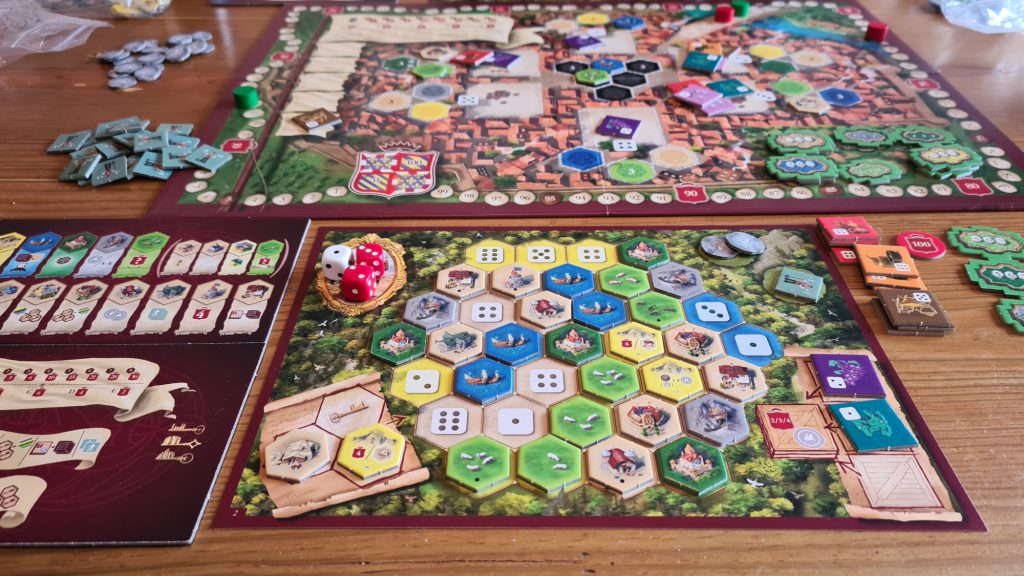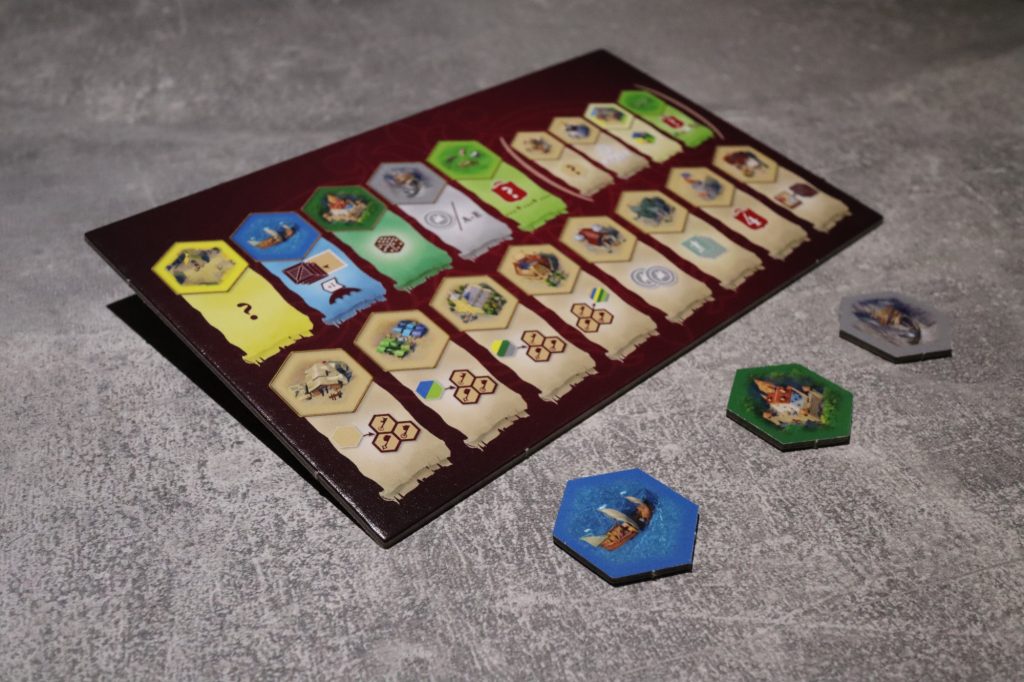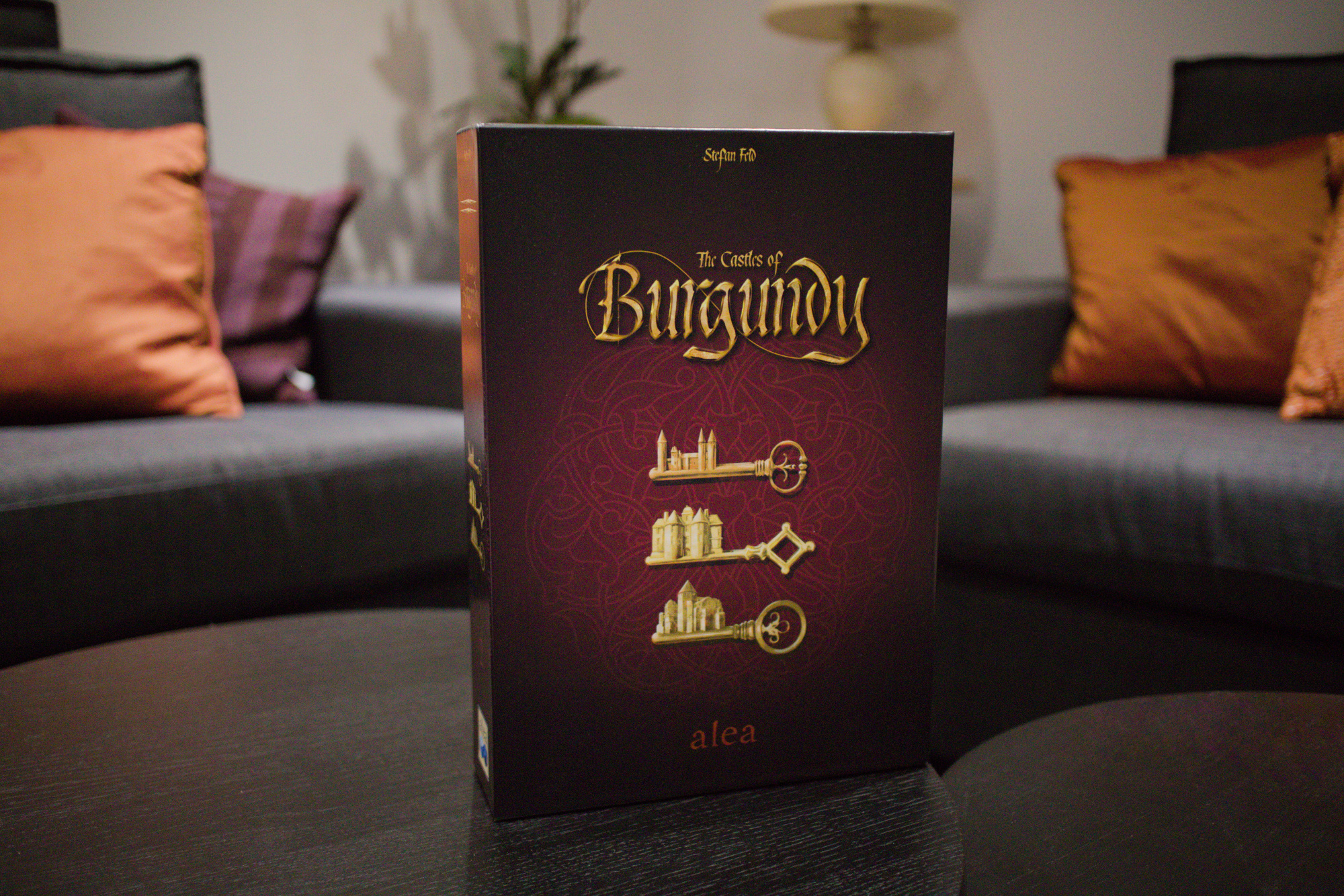The Castles of Burgundy is a dice based, territory building, board game from publisher Ravensburger. Designed by Stefan Feld, the game sees 1 – 4 players become aristocrats in medieval France. Starting with a single castle these aristocrats build out settlements, use the rivers to trade, farm vast fields and even mine the region for silver. However, does The Castles of Burgundy only manage silver or does it go for gold? Let’s find out!
After setting up the board depending on the player count, 5 piles of 5 goods will have been made, the first range of hexagonal tiles will have been distributed to the 6 numbered depots and players will have their player boards, dice and starting silver coins/workers. Played out over 25 rounds, across 5 phases, the first stack of 5 good tiles is moved to the game rounds zone, with each round seeing the next taken, thus being a tracker of sorts.
Each round the starting player rolls the white die, with all players simultaneously also rolling their two dice. The result of the white die isn’t used by the starting player, it just denotes the depot where the top most good token should be placed. The starting player can then spend their two dice to take a tile, place a tile, sell goods or take two worker chips. To take a tile the player spends a die, with a value matching the numbered depot where the tile is located. Purchased tiles are placed into one of the three storage slots on the player’s personal board. Whilst players can discard a tile already there to make room, it is rarely something players would want to do.
A player could instead spend a die to place a tile onto their player board from their storage. The die value must match the location they wish to place the tile, that hexagon space must be adjacent to an already placed tile in their region and the tile type must match. For example,a pasture must be placed on a light green space on the player’s board. With tile types from mines to town buildings, and monasteries in the middle, each benefits players in a different way. Mines will reward players with a silver coin at the end of each phase, while pastures score points depending on the number of the same animals in that field. Placing boats allows the player to take all of the good tiles from any depot they wish and moves them forward on the turn order tracker.
Each of the 8 buildings have unique effects, from taking a boat or livestock tile for free from a depot to claiming 4 worker tokens. Then there are monasteries which give on-going benefits. These can effectively upgrade actions, perhaps seeing players also gain coins when spending dice for workers, or new ways to score points. Workers are tiles which can be spent at any time to increase or decrease a die value. These help players get the die values they want and players can gain two by spending one of their dice, regardless of the pip value.
The final action sees the player sell all of their goods of a specific value, naturally being the value of the used die. This sees some points earnt based on the amount sold, with a single silver coin always earnt. Additionally, on their turn players can spend two silver pieces to take a tile from the black market. Doing this does not spend one of the players dice, with the tile added to their storage as usual.

Regardless of the actions taken, play then moves onto the next player. Past the initial round this won’t be clockwise, being based upon the turn order tracker – with players further along the tracker going first, or if on the same space of the tracker the player on top goes first. Each of the 5 phases have 5 rounds. At the end of each phase unclaimed tiles are removed, though goods remain, before a new range of tiles is placed out into the depots.
Throughout the game players gain bonus points for filling a region on their player board. These points are based upon the size of the region, for example a 3 sized zone scores 6 points. Then, an additional bonus is scored based on the current phase – with more points scored the earlier in the game a zone is completed. On top of this players claim bonus tiles if they are the quickest to fully cover all hexagon spaces on their board of a specific colour.
At the end of the final phase it is time to score with unspent silver, worker tokens and goods taken into account, and bonus points from monasteries determined. These are all added to the point totals players managed during the game. The player with the most points wins, with ties split by the fewest unused spaces on their player board.
The idea of the theme is an enticing one, with rivers, mines, towns and more. The Castles of Burgundy tries to suggest the theme is there, though it is one of the more forgettable ones in board gaming. Building names aren’t learnt with them skipped in players minds, seen only for their abilities. Rivers are just an excuse to trade and don’t exactly snake through regions. Nevertheless, as abstract as the theme is, it is somewhat useful for teaching the game, though once past this point players will only see potential points and not churches, workshops and markets.
Players have a tonne of decisions to make. This means when something pays off it feels rewarding, though there is a potential downside for some players. If you are prone to a spot of analysis paralysis, staring at a range of options and needing to calculate what is best, you’ll easily see the time tick by. This is only exacerbated if playing with more players, with the game time increasing per player before any of them start spending long periods of time planning and thinking.
Rolling dice is always going to inject a spot of luck into the experience. Thankfully, players have a few ways of mitigating this. From worker chips to change the value on the dice, to monastery abilities, players have some tricks up their sleeves. The key point is though that rolling a 6 is not consistently better than rolling a 1. Every round players may have their eye on a specific tile and the depot number is what they will want to roll. Worst comes to worst, players can normally spend one dice to gain workers to add or subtract values from their second dice to accomplish this. Therefore, while luck is involved it’s more about working around what is rolled than being completely stuck with the values.

There is no getting around the fact that the monastery tiles need to be looked up a lot in the first game, reducing over the following couple of plays. It would have been much easier if in that initial play there had been a set of monasteries that just gave points when built. They add a lot of the choices into the game and buff actions, making the game sing when getting the game back to the table. It would have been a nicer introduction though not to have to reference the rulebook as heavily. It would also open the game up to more players with this being less complex as a result, so it could be a family mode of sorts.
A range of expansions are included in the box, though it is not advisable to throw them in from the get go. These have mostly been released before as promotional items, with the likes of geese, additional monastery tiles and more included. These rarely impact the difficulty of the game, often reusing or featuring similar iconography to other tiles. Still, they would be another thing to remember, so best to leave them in the box for the first few players.
One brand new mini expansion is included, the shields. This sees players able to spend doubles to take a shield tile to place onto one of their castles. These have strong abilities such as linking all of pastures or being able to set one die each round to any value. Unlike other expansions which just add a new spin on something or extend the normal gameplay logics, shields cannot be ignored – so fans of the fine tuned gameplay the base game offers might not be sold on its inclusion.
While plenty of plastic bags are included for all of the components the lack of an insert does hamper setup time. Almost every tile type can be stored in their own bag. This is a certain positive, though the bags are see through. At the start of the game players will need to make piles of the various tile types, a job made easier via the coloured backs of tiles. Every tile must be flipped face down though, and as much as the little niceties such as the bags and the tile backs are, having cloth bags would have negated the need for a lot of the effort during setup.
There is no doubt that the 2019 printing, the edition of The Castles of Burgundy in the review, is more colourful, brighter and aesthetically pleasing than the original version. Despite leaving a lot of the beige behind it is still behind many games in the visual department though. The tiles have simple yet easy to recognise artwork on them, especially helpful for the readability of the buildings tiles. Then there is the commendable use of symbology for the buildings and monasteries, which once learnt make playing a breeze. This version faced backlash originally and it seems more to do with it initially being sold as an anniversary edition. This almost boosted gamers expectations of this new printing, so while not the most eye catching nor the most jaw dropping in quality it perhaps has been harshly shunned.
The Castles of Burgundy is a much loved game and it is easy to see why. Seeing past the theme is unfortunately rather easy, despite it being a generally pleasant one – with players regions being slowly filled out with tiles. The underlying game though is full of meaningful choices and decisions. From how to use dice to which type of tiles to focus on first, players get points from such a variety of sources each game players can try a different route to victory. Regardless of how well players do they can at least feel they have achieved something, thanks to this point salad like approach. It may have a few things to get your head around in an initial playthrough. Otherwise, The Castles of Burgundy is a great experience to introduce those wanting to explore past gateway games.
(Editor’s Note: The Castles of Burgundy was provided to us by Ravensburger for the review.)

